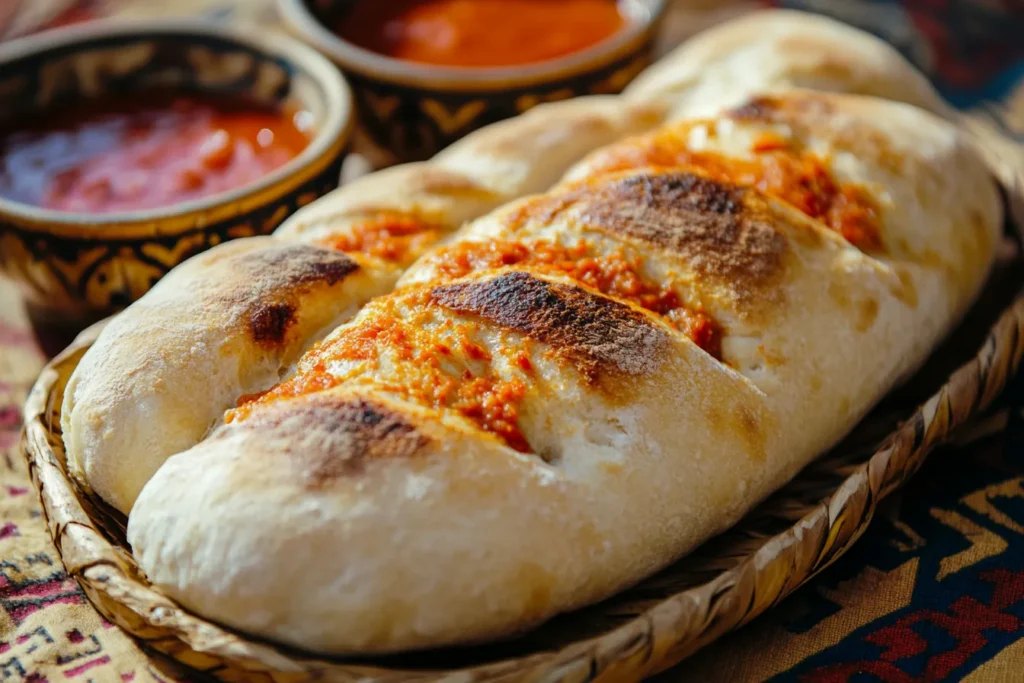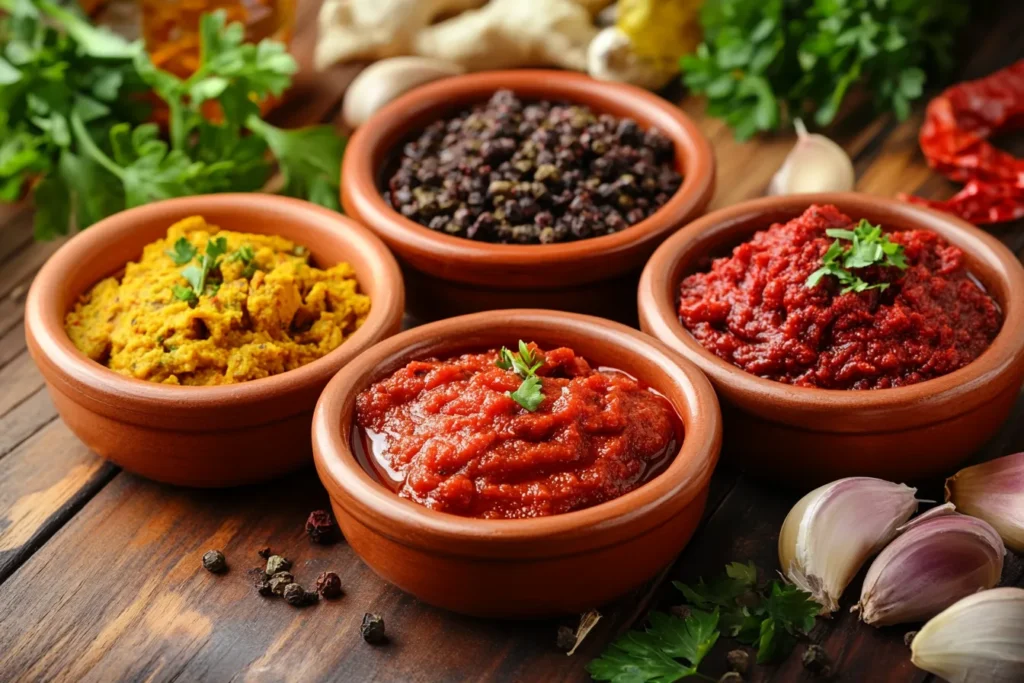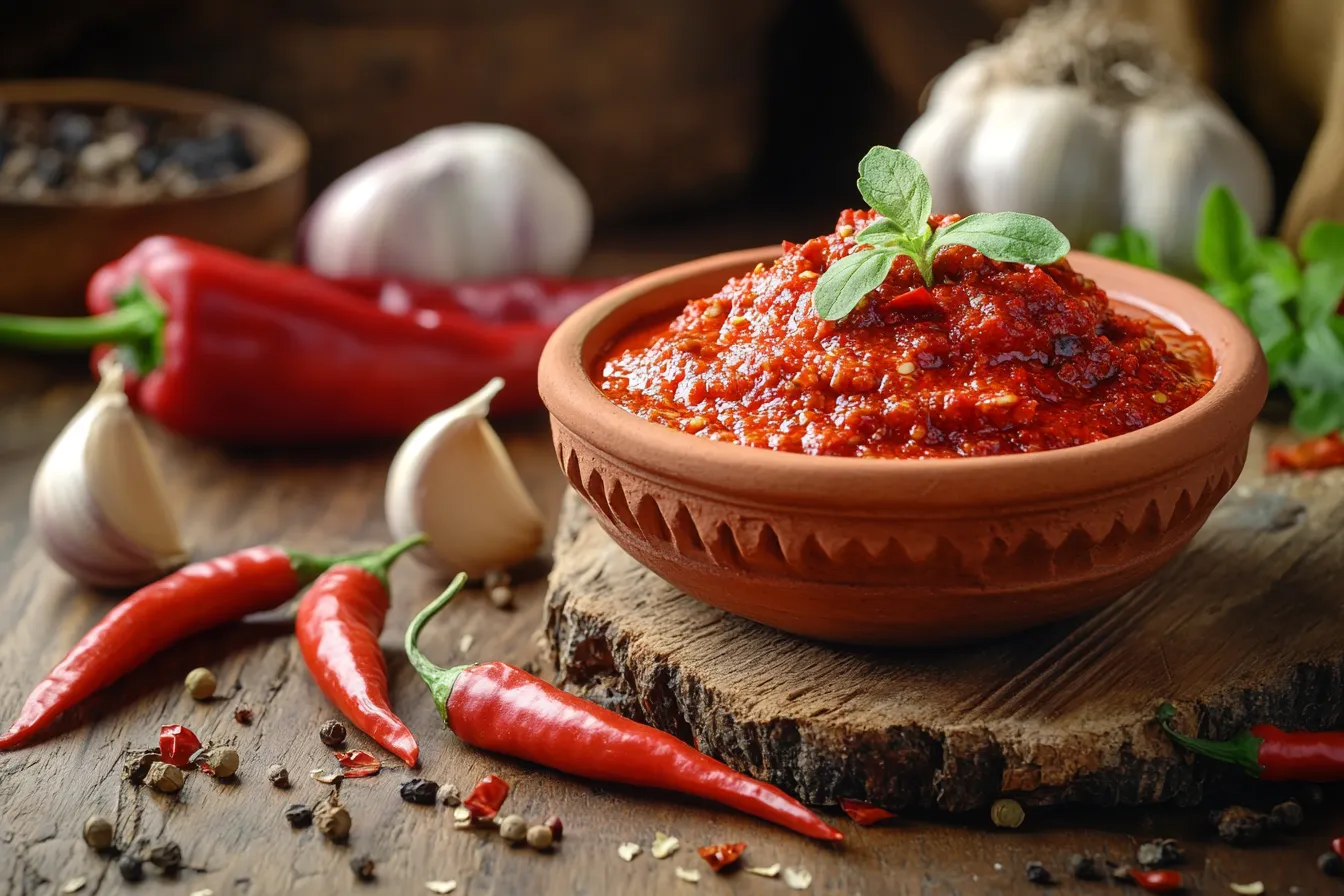Introduction
If you have ever sampled the vibrant, fiery dishes of Tunisia, there is a good chance you’ve tasted a spicy sauce used in many Tunisian dishes known as harissa. This deep-red, chili-laden paste is far more than just a condiment — it is a symbol of Tunisian culture and tradition, a beloved element of family cooking, and a culinary ambassador for the region. From humble street food stalls to refined restaurants, harissa is woven into nearly every corner of Tunisian life..Mango Habanero Sauce Recipe
In this guide, you’ll discover what makes this spicy sauce so unique, explore its fascinating history, and even learn how to make it yourself. Whether you’re a spice lover or a curious cook, this deep dive will help you appreciate why harissa has gained international fame while staying rooted in Tunisian hearts.
What Is Harissa? The Spicy Sauce in Tunisian Cuisine
Harissa is a thick, fiery chili paste traditionally made from sun-dried hot red peppers, garlic, olive oil, spices like coriander and cumin, and sometimes preserved lemons. Its heat can range from a gentle warmth to a tongue-scorching fire depending on the blend of peppers and spices used.
In Tunisia, harissa is the spicy sauce used in many Tunisian dishes — stirred into stews, rubbed onto meats, folded into couscous, or simply served on the side as a condiment. Unlike bottled hot sauce, harissa has a dense, paste-like consistency, which makes it perfect for spreading and marinating.
Origins and Cultural Significance of Harissa
The roots of harissa run deep in Tunisian food culture. Historians trace its introduction back to the 16th century, when chili peppers arrived from the Americas through trade routes. Over time, Tunisian cooks blended these peppers with local spices and olive oil to create what we know today as harissa.
It quickly became essential to Tunisian households — a way to preserve summer chili harvests for use year-round, while also adding bold flavor to otherwise simple dishes. Today, harissa is celebrated as a true cultural icon, recognized far beyond Tunisia’s borders as a key piece of North African cuisine.
You’ll find harissa in everything from family recipes to street foods, and its fiery aroma is familiar in homes across the country. For many Tunisians, a kitchen is not complete without a jar of this bright-red paste.

Key Ingredients in Harissa
The appeal of harissa lies in its simplicity yet depth of flavor. Here are the main ingredients you’ll find in most authentic recipes:
- Dried hot red chili peppers – the soul of harissa, giving it its signature fire
- Garlic – balances heat with a mellow depth
- Olive oil – smooths the paste and acts as a preservative
- Spices – typically coriander, caraway, cumin, and sometimes smoked paprika
- Salt – essential for seasoning and preservation
- Optional lemon – some regional harissas add preserved lemon for a tangy kick
Tunisian families often grind these ingredients by hand using a mortar and pestle, maintaining a rustic, traditional texture that is worlds apart from mass-produced harissa.
How Tunisians Use This Spicy Sauce
Harissa is incredibly versatile. It is used to:
- Flavor couscous, Tunisia’s national dish
- Marinate lamb, chicken, or fish before grilling
- Stir into soups or vegetable stews for a rich heat
- Spread onto bread alongside olive oil as a snack
- Accompany grilled meats at the table as a dipping sauce
In many homes, harissa is even brought to the breakfast table, served with bread and olive oil to start the day with a fiery kick..Glaze made with Soy Sauce and Mirin Crossword
For a deeper dive on Tunisian cuisine in general, check out Tunisian cuisine for more cultural context.
Regional Variations of Harissa
Not all harissa tastes the same. Different parts of Tunisia have their own spin on this spicy sauce:
- Cap Bon harissa – from the Cap Bon peninsula, famous for its bright flavor and moderate heat
- Gabes harissa – often smokier with a richer color
- Homemade harissa – varies from family to family depending on the balance of garlic, spice, and oil
These regional twists mean no two jars are ever identical, and harissa remains a deeply personal and local product even as it gains global fame.
Health Benefits of Harissa
Harissa isn’t just delicious — it’s healthy, too! Thanks to its base of chili peppers, harissa is loaded with capsaicin, which has been linked to:
- Boosted metabolism
- Reduced inflammation
- Antioxidant benefits
- Supporting cardiovascular health
Plus, harissa is made with simple, whole-food ingredients, making it a cleaner and healthier alternative to processed hot sauces. If you are curious about traditional food health, check out this article on the culinary gem of Tunisia for more insight.

How to Make Traditional Tunisian Harissa at Home
If you want to bring a taste of Tunisia into your kitchen, making harissa at home is surprisingly easy. Here’s a simple traditional method:
Ingredients:
- 10 dried red chili peppers
- 4 cloves garlic
- 2 tablespoons olive oil
- 1 teaspoon coriander seeds
- 1 teaspoon cumin seeds
- ½ teaspoon caraway seeds
- ½ teaspoon salt
- 1 tablespoon lemon juice (optional)
Instructions:
- Soak the dried peppers in warm water until soft, then drain.
- Toast the coriander, cumin, and caraway seeds until fragrant.
- Grind the spices with garlic and salt.
- Add the peppers and blend into a smooth paste.
- Slowly drizzle in olive oil to form a thick, shiny sauce.
- Mix in lemon juice if desired.
Store the harissa in a sterilized jar with a layer of olive oil on top, and it will keep for weeks in the fridge.
Modern Takes on Tunisian Harissa
Chefs across the world are embracing harissa’s deep, spicy flavor. In Europe and North America, you’ll find it in trendy restaurants as a flavor booster for everything from roasted vegetables to artisan sandwiches. Its rise on social media platforms like TikTok and Instagram has made it a global trend, with food lovers praising its smoky, complex heat.
Some brands even produce milder harissa for global palates while maintaining the essential spirit of this spicy sauce. But nothing quite compares to the authentic, homemade versions you’ll taste in Tunisia.

FAQ
What does harissa taste like?
Harissa tastes smoky, spicy, and slightly tangy, with hints of garlic and earthy spices.
Is harissa extremely spicy?
Traditional harissa can be quite hot, but you can adjust its spice level by choosing milder peppers.
Can I buy harissa outside Tunisia?
Yes! Many international grocery stores now carry harissa in jars or tubes.
How do Tunisians serve harissa?
They serve it with couscous, meat dishes, or simply on bread with olive oil.
Is harissa the only spicy sauce in Tunisia?
While harissa is the most famous, there are other chili-based condiments used locally.
How long does homemade harissa last?
Stored properly under a layer of olive oil in the fridge, it can last for about 3–4 weeks.
Conclusion
The spicy sauce used in many Tunisian dishes is more than just an ingredient — it is a legacy of flavor, tradition, and culture. Whether you buy a jar at the supermarket or make your own at home, harissa is a fiery link to the warm hospitality and bold culinary spirit of Tunisia.
Why not experiment with harissa in your own kitchen? A spoonful of this rich, spicy paste can transport your taste buds straight to North Africa — no passport required!

Name: Spicy Tunisian Sauce (Harissa)
Ingredients
Equipment
Method
- Instructions:
- Soak the dried red peppers in warm water until soft, then drain.
- Toast the coriander, cumin, and caraway seeds in a dry pan until aromatic.
- Crush the toasted seeds with garlic and salt in a mortar and pestle or blend them in a food processor.
- Add the softened chili peppers and grind into a smooth paste.
- Gradually add the olive oil while mixing to form a thick, shiny paste.
- Stir in the lemon juice if desired.
- Store in a clean jar, topped with a thin layer of olive oil to preserve freshness.
